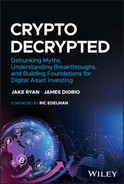PART III
THE BREAKTHROUGH
In Part Three, we focus on the innovation of all the technology that is at the heart of making the future possible. It’s technological innovation that allows us to do things we couldn’t do before. Moving value across borders and doing so without human intervention in a peer‐to‐peer fashion wasn’t possible prior to blockchain technology. New forms of money can now be created. The converging of IoT, AI, and robotics with blockchain using digital assets allows a new future to be possible. As companies compete, it’s technology that gives an edge against competitors.
There’s a concept we love from Andreas Antonopolous called “infrastructure inversion.” Look it up on YouTube, because it’ll be worth your time. The idea encapsulates a period of time in a new technological revolution when the new innovation is being played with and utilized by the early adopters, then new infrastructure gets laid out, and then you can do anything from the past easier/faster/cheaper plus a whole lot more. The new infrastructure that is laid out on top of the old infrastructure creates conflict initially. In the beginning of the adoption of new technology, it is implemented on the existing technology that it’s disrupting and at first glance it looks useless.
Andreas starts his video out with an example from the oil and automobile technological revolution.1 He starts out by explaining the complainers of the “new tech”: What are these automobiles? Those noisy machines are going to kill us all. You can’t feed them and how do you travel over 100 miles? Why would anyone want to use those crazy contraptions when we have perfectly good horses? Their tires get stuck in the mud and they’re death traps, killing people who don’t see them coming. What are these rich people doing with these toys? Horses with carriages are much better. You see, that’s what happens when innovation is initially employed; it’s met with resistance at first.
Now, 20 years into the new technological revolution, its innovation looks obvious in hindsight. When roads and interstates and gas stations become prevalent, the use of cars seems obvious. However, in those early years, it’s hard to explain to the masses. We hope this part of the book helps explain why and how the current innovations are going to revolutionize everything we think about commerce, transacting, and requiring trust to do so.
During the Internet Age, if companies didn’t figure out a digital communication strategy, they were left in the dust. Just ask Blockbuster. It’s the same this time around. As companies and organizations are able to implement more autonomous operations, they create a competitive edge. In this part of the book, we aim to illustrate all the technology and to give an understanding of what got solved from a problem standpoint and what’s now possible.
